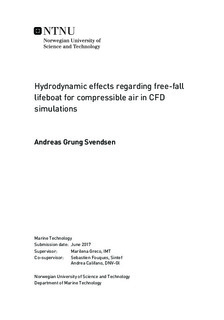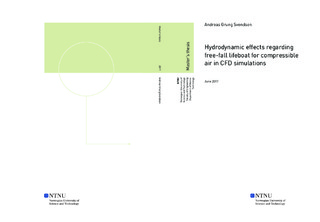| dc.description.abstract | Free falling lifeboats are often used as a last resort evacuation system for fixed or floating offshore installations. Lifeboats are normally resting at a skid which is mounted at the mother vessel, until the hook holding the lifeboat at rest is released. It is important that lifeboat diving is a safe evacuation method. Therefore, the physics related to life boat diving phenomenon is important. Lifeboat diving is divided into launching phase, free falling phase, water entry phase, submerged phase, water exit phase and sail away phase. For a better understanding, these phases are included in a literature study, and compared with relevant literature for each phase. In this master thesis, lifeboat diving has been investigated using computational fluid dynamics (CFD), where the selected solver has been Star-CCM+.
A sensitivity analysis and convergence study were conducted for the incompressible simulation, with focus on how the time step, number iteration and mesh discretization influenced the simulation. This lead to a suitable relation between mesh discretization and time step, including 10 iterations. A convergence analysis was conducted in pursuance of an indication of how much the simulation was effected by the mesh discretization. The two finest mesh discretization were quite similar to each other in a global perspective such as motion, though local phenomena, especially in connection with cavity closure proved different. The order of accuracy was calculated under the assumption that the error approximated for a given quantity was proportional to , where is the mesh discretization and OA is the order of accuracy. Since no experiments have been carried out, the exact solution for the problem was unknown. Therefore, a log linear relationship was assumed between the integrated quantity and mesh discretization, in the interest of finding the optimal solution, which the solver should converge towards. The coarsest grid discretization might miss out on important phenomena due to the large cell size, further influencing the physics. Hence a log linear relation between the integrated quantity and mesh discretization is probably an inaccurate statement for this mesh discretization.
The physics related to a freefalling lifeboat is highly influenced by many parameters, such as wind loads, drop height and wave conditions. It is important to know how these parameters will influence the behavior of the lifeboat. Therefore, a parameter investigation was conducted in collaboration with Simen Groth and Vegard Netland. The main focus was to investigate how various parameters such as maximum submergence, sailing distance and accelerations were influenced by the different initial conditions when air was modeled as incompressible. The lifeboat behavior was less influenced by a change in the vertical position of the COGbody.The maximum submergence and sailing distance were increased, when the COGbody was raised in direction. The maximum submergence height was most influenced when the water entry angle was reduced or increased by 5 degrees from the initial water entry angle of 60 degree. The change in initial resultant velocity at water entry contributed also to large variations in the submergence. However, the sailing distance proved to be the parameter most effected by the initial water entry velocity. In addition, the cavity closure occurred earlier when the velocity was increased.
To investigate the influence of the compressibility of the air, three different compressible air relations where introduced to the software. These models were based on previous studies regarding air cushions in a tank due to slamming and CFD analysis with air modelled as compressible. The most significant difference was that the pressure on the aft part of the body started to oscillate with a frequency close to the natural frequency of the entrapped air, after cavity closure for the compressible air models. For the incompressible air simulation, only one distinctive pressure peak with much greater amplitude was present. The first pressure peak was also observed later, which might be a result of the compression of the entrapped air, before creating an instant push on the aft part of the body. These pressure oscillations on the aft part of the body, results in oscillating acceleration in direction for all the compressible models. The oscillating acceleration in direction, seems to oscillate with a mean value close to the acceleration in direction for incompressible air, since both the velocities and motions are quite similar, though the sailing distance is a bit longer for incompressible air. The large acceleration peak in direction for incompressible air will distinguish when the specified filter for calculations of CAR index is applied. Therefore, incompressible air simulations are most likely appropriate when estimating passenger safety. As for the structural integrity, pressure peaks may cause local failure. As a result of this, filters should not be used for the purposes of removing pressure peaks. In addition, the pressure measurements for compressible and incompressible are quite different. Hence, air should be modelled as compressible for an accurate structure assessment.
The natural frequency for the various compressible air models were found. The polytrophic gas relations showed a smaller natural frequency, compared to the adiabatic relation, which corresponds well with previous studies. The isothermal condition indicated the lowest natural frequency, which was also the case for Ommundsens simulations. The damping ratio of the pressure oscillations was investigated by assuming that the damping resembles the free decay of an under damped linear mass system. In order to get an accurate estimate of the damping, the varying hydrostatic pressure had to be subtracted. This was done by using a second order Butterworth high pass filter, attenuating frequencies below 1Hz. The reason for conducting the polytrophic gas relation was due to the assumption that heat exchange contributes to damping of the entrapped air, which is not represented when an adiabatic process is assumed. The damping ratio for the polytrophic gas relation was slightly higher than adiabatic, but lower than the damping ratio for the isothermal condition. The author would recommend further studies with the polytrophic gas relations on the grounds of higher natural frequency than the isothermal condition and slightly higher damping ratio compared to the adiabatic process. | |

